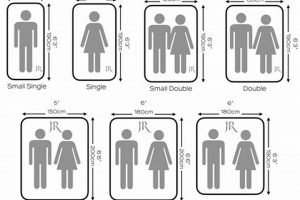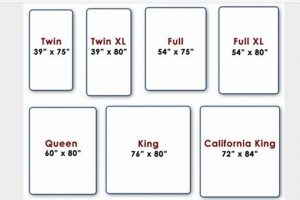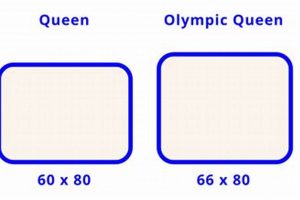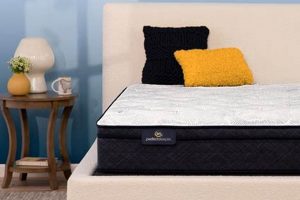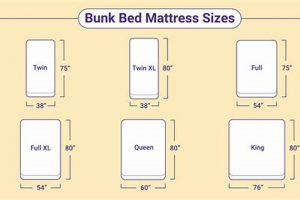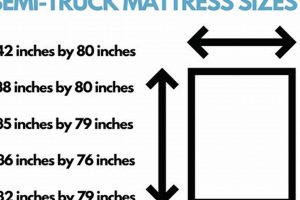A recreational vehicle mattress dimension commonly mirrors that of a standard queen, but with adjustments for the typically smaller spaces found in RVs. These mattresses often measure approximately 60 inches wide by 80 inches long, though variations exist to accommodate specific RV layouts. For example, a short queen may be employed, maintaining the 60-inch width but reducing the length to around 75 inches. This dimensional consideration is essential when selecting a replacement mattress for an RV.
The importance of selecting an appropriately sized mattress relates directly to comfort and space optimization within the RV. A correct fit ensures ease of movement within the sleeping area and prevents obstruction of other RV features. Historically, RV mattresses were often viewed as secondary to other vehicle components; however, recognition of sleep’s crucial role in well-being has led to increased emphasis on mattress quality and dimensions. This shift reflects a broader trend towards enhanced comfort and livability in recreational vehicles.
Subsequently, the following sections will delve into the material options available for these mattresses, focusing on considerations such as weight and breathability. We will also address the process of accurately measuring the available space within an RV to ensure compatibility with various mattress types, and explore the impact of mattress thickness on overall comfort and storage capacity within the vehicle.
Tips Regarding Recreational Vehicle Queen Mattress Dimensions
The following guidelines are intended to assist in the selection and integration of a queen-sized mattress within a recreational vehicle, focusing on practical considerations and space optimization.
Tip 1: Accurate Measurement is Paramount: Before purchasing, meticulously measure the available sleeping area within the RV. Account for any obstructions, such as wheel wells or built-in furniture, that may impact mattress dimensions. Record the length, width, and maximum allowable thickness.
Tip 2: Consider a Short Queen: If space is constrained, a short queen mattress, typically 60 inches wide by 75 inches long, may offer a viable alternative. This dimensional modification can significantly improve maneuverability within the RV.
Tip 3: Assess Weight Restrictions: Recreational vehicles have specific weight capacities. Factor in the weight of the mattress, especially when considering memory foam or hybrid models. Opt for lighter materials to minimize the overall load.
Tip 4: Prioritize Breathability: RV interiors can become warm and humid. Select a mattress with breathable materials, such as open-cell memory foam or latex, to promote airflow and prevent overheating.
Tip 5: Evaluate Corner Configurations: Certain RV layouts necessitate mattresses with rounded or beveled corners. Precisely assess the corner geometry of the sleeping platform and choose a mattress that conforms accordingly. Custom-made mattresses are sometimes required to achieve an optimal fit.
Tip 6: Check for Adequate Support: Regardless of size considerations, ensure the chosen mattress provides adequate spinal support. Test different mattress types to determine the level of firmness and support best suited to individual needs.
Tip 7: Plan for Mattress Rotation: Regularly rotate the mattress to promote even wear and extend its lifespan. Consider the ease of rotation when selecting a mattress material and construction.
Adherence to these guidelines facilitates the selection of a recreational vehicle queen mattress that optimizes comfort, maximizes space utilization, and ensures compatibility with the specific RV model.
Following these practical tips, the subsequent sections will elaborate on specific mattress material options and their suitability for the RV environment.
1. Width Accommodation
Width accommodation, in the context of “queen rv mattress size,” denotes the essential requirement of ensuring the mattress’s lateral dimension aligns precisely with the available space within the recreational vehicle’s sleeping platform. Failure to adequately consider this factor results in a mattress that either fails to fit or, if forced into the space, suffers premature wear and structural damage. For example, if the RV sleeping area measures 58 inches wide, and a standard 60-inch queen mattress is purchased, the mattress will be compressed, leading to uneven wear and potential damage to both the mattress and the bed frame.
The importance of width accommodation stems directly from the compact nature of recreational vehicles. Unlike residential settings, space is a premium. A mattress that extends beyond the designated area impedes movement, obstructs access to storage compartments, and disrupts the overall usability of the RV. Furthermore, forcing an oversized mattress into a smaller space compromises its structural integrity and reduces its lifespan. The dimensions of the RV’s sleeping area dictate, without exception, the maximum permissible width of the replacement mattress.
In summary, width accommodation is a non-negotiable component of successful mattress selection for RVs. Accurate measurement and adherence to the specified width ensure comfort, longevity of the mattress, and efficient utilization of the limited space within the recreational vehicle. Neglecting this dimension introduces significant practical challenges and undermines the intended functionality of the sleeping area.
2. Length Variation
Length variation, as it pertains to recreational vehicle queen mattress dimensions, signifies the deviation from the standard 80-inch length commonly associated with residential queen mattresses. This variation is a direct consequence of space constraints inherent in RV design, where maximizing usable living area often necessitates a reduction in sleeping space. A shorter mattress length, typically 75 inches in the case of a “short queen,” directly correlates to increased floor space and improved maneuverability within the RV. For instance, a Class B RV with limited sleeping quarters benefits significantly from a short queen, freeing up valuable space for movement and storage.
The selection of an appropriate mattress length necessitates careful consideration of the RV’s internal layout and the occupants’ height. While a shorter mattress offers space advantages, it may compromise comfort for taller individuals. The trade-off between space optimization and sleeping comfort must be evaluated based on individual needs and preferences. Furthermore, the length variation impacts the availability of bedding options. Standard queen-sized sheets may require alteration or custom fitting to accommodate a short queen mattress. Numerous suppliers specializing in RV bedding offer tailored solutions to address this issue, providing pre-cut sheets and blankets designed for shorter mattress dimensions.
In conclusion, length variation represents a practical adaptation to the spatial limitations of recreational vehicles. The choice between a standard and a short queen mattress hinges on a balance between space optimization and individual comfort preferences. Understanding the implications of length variation, from bedding compatibility to occupant suitability, is critical in ensuring a comfortable and functional sleeping arrangement within the constraints of the RV environment. Overlooking this aspect may result in compromised comfort or inefficient utilization of available space.
3. Thickness Impact
The thickness of a recreational vehicle queen mattress significantly influences multiple aspects of the RV experience, extending beyond mere comfort considerations. A mattress with excessive depth reduces headroom, particularly in RVs with low ceilings or over-cab sleeping areas. This diminished vertical space can create a claustrophobic environment and hinder ease of movement within the sleeping area. Conversely, an overly thin mattress may compromise support and pressure relief, leading to discomfort and potential sleep disturbances. The selection of mattress thickness, therefore, requires careful evaluation of the available vertical space and the desired level of comfort.
Furthermore, mattress thickness directly affects the usability of storage compartments located beneath the bed platform. A thicker mattress consumes a greater portion of the available vertical space, thereby reducing the volume of accessible storage. This limitation can be particularly problematic in smaller RVs, where storage is at a premium. For example, a 12-inch mattress may render under-bed storage compartments largely unusable, forcing occupants to seek alternative storage solutions. Conversely, a thinner 6-inch mattress maximizes storage capacity but may compromise comfort and support. Therefore, a balance must be struck between mattress thickness, storage requirements, and the overall comfort needs of the RV occupants.
In conclusion, the thickness of a queen RV mattress is a critical factor that impacts headroom, storage capacity, and overall sleeping comfort. Understanding the trade-offs associated with varying mattress thicknesses is essential for selecting a product that optimizes both functionality and comfort within the limited confines of a recreational vehicle. Ignoring this aspect can lead to compromised comfort, reduced storage space, and a less enjoyable RV experience. Prudent selection involves accurate measurement of available space, careful consideration of storage requirements, and a realistic assessment of individual comfort preferences.
4. Weight Limitation
Weight limitation is a critical consideration in the selection of a queen RV mattress, directly affecting the recreational vehicle’s operational safety and fuel efficiency. Overlooking this aspect can lead to compromised handling, increased wear and tear on vehicle components, and potential safety hazards during transit. The weight of the mattress, especially when combined with other cargo, contributes to the RV’s gross vehicle weight rating (GVWR), a maximum limit established by the manufacturer.
- Impact on Fuel Efficiency
Excess weight directly correlates with diminished fuel economy. A heavier queen RV mattress increases the overall load on the vehicle, requiring the engine to expend more energy to maintain speed and navigate inclines. This increased energy consumption translates to higher fuel costs and a reduced driving range. For example, a memory foam mattress weighing significantly more than a traditional innerspring mattress will noticeably impact fuel consumption, especially on long journeys.
- Effect on Vehicle Handling
Exceeding weight limits can negatively affect the RV’s handling characteristics. A heavier mattress contributes to a higher center of gravity, making the vehicle more susceptible to swaying and instability, particularly in windy conditions or during sudden maneuvers. This can compromise driver control and increase the risk of accidents. The load distribution within the RV, influenced by the placement and weight of the mattress, further exacerbates these handling issues.
- Strain on Suspension and Tires
A heavier queen RV mattress places increased stress on the vehicle’s suspension system and tires. Over time, this can lead to premature wear and tear on these components, necessitating more frequent repairs and replacements. Overloaded tires are also at a higher risk of blowouts, posing a significant safety hazard. Regular inspection and maintenance of suspension and tire components are crucial when carrying a heavier mattress.
- Compliance with GVWR Regulations
Exceeding the RV’s GVWR is a violation of safety regulations and can result in fines or penalties. Weight limitation is directly related to the overall permissible weight, meaning selecting a lighter RV queen mattress directly correlates with the RV’s overall permissible weight and allows for additional cargo to be packed safely and legally. This compliance ensures the safety of the occupants and other road users.
In summary, the weight of a queen RV mattress is not merely a comfort consideration but a fundamental safety and operational factor. Careful attention to weight limitations, coupled with informed selection of mattress materials and construction, is essential for ensuring a safe, efficient, and enjoyable recreational vehicle experience. Neglecting this aspect can have significant consequences, ranging from increased fuel costs to compromised vehicle handling and potential safety hazards.
5. Corner Geometry
Corner geometry, within the context of recreational vehicle (RV) queen mattress dimensions, refers to the shape and configuration of the mattress’s corners, specifically in relation to the RV’s interior structure. Unlike residential bedrooms, RV sleeping spaces often feature non-orthogonal layouts due to wheel wells, cabinetry, and other built-in features. Consequently, standard rectangular mattresses may not fit optimally. Corner geometry addresses this challenge by employing rounded, beveled, or otherwise modified corners to conform to the specific contours of the RV’s sleeping area. This ensures a snug fit, maximizing usable space and preventing obstructions. The shape must match that of the platform it would be placed.
The practical significance of understanding corner geometry lies in preventing ill-fitting mattresses that impede movement, block storage access, or create uncomfortable sleeping conditions. For instance, if an RV bed frame features rounded corners to accommodate a curved wall, a standard rectangular mattress will leave gaps, diminishing usable space and potentially creating a tripping hazard. Conversely, attempting to force a rectangular mattress into a rounded space can damage both the mattress and the bed frame. Custom-made mattresses are often required to achieve the optimal fit, specifically when complex or irregular corner geometries are present. The dimensions, including all angles, must be precise to meet its needs.
In summary, corner geometry is a critical component of “queen rv mattress size” selection, ensuring compatibility between the mattress and the RV’s internal structure. Overlooking this aspect can lead to wasted space, compromised comfort, and potential damage to the mattress or RV. Accurate measurement of the sleeping area, including the precise shape of the corners, is essential for selecting a mattress that optimizes both functionality and comfort within the confined environment of a recreational vehicle. This precision contributes directly to efficient space utilization and an enhanced overall RV living experience.
Frequently Asked Questions
The following section addresses common inquiries regarding queen-sized recreational vehicle mattresses, focusing on dimensional considerations and practical implications.
Question 1: How do queen RV mattress dimensions differ from standard residential queen mattresses?
Recreational vehicle queen mattresses frequently vary in length compared to their residential counterparts. While standard queen mattresses measure 60 inches wide by 80 inches long, RV queen mattresses may be shorter, typically 75 inches, to accommodate the limited space within recreational vehicles. The width generally remains consistent at 60 inches.
Question 2: What is a “short queen” mattress, and when is it appropriate for an RV?
A “short queen” mattress refers to a queen-sized mattress with a reduced length, typically measuring 60 inches wide by 75 inches long. It is appropriate for RVs with limited sleeping space, where a standard 80-inch mattress would impede movement or block access to other features. Short queen mattresses maximize usable space within the RV.
Question 3: How does mattress thickness impact RV functionality?
Mattress thickness affects headroom, storage capacity, and overall comfort. A thicker mattress reduces headroom and diminishes accessible storage space beneath the bed platform. Conversely, an overly thin mattress may compromise support. Selecting a mattress thickness that balances comfort and functionality is essential.
Question 4: Why is weight a significant factor when choosing a queen RV mattress?
The weight of an RV mattress contributes to the vehicle’s gross vehicle weight rating (GVWR), affecting fuel efficiency, handling, and suspension wear. Exceeding the GVWR can lead to safety hazards and regulatory penalties. Lighter mattress materials minimize the overall load on the vehicle.
Question 5: What are corner considerations when selecting a queen RV mattress?
RV sleeping areas often feature non-standard corner geometries. Standard rectangular mattresses may not fit optimally. Rounded or beveled corners facilitate a snug fit, maximizing space utilization and preventing obstructions. Custom mattresses may be necessary for complex corner configurations.
Question 6: How can accurate measurement ensure proper mattress fit in an RV?
Precise measurement of the RV’s sleeping area, including length, width, and corner geometry, is crucial for selecting a compatible mattress. Overlooking this step can result in a mattress that does not fit properly, compromising comfort and functionality. Measure the space to ensure both length and width are accommodated appropriately.
In summary, the selection of a queen RV mattress requires careful consideration of dimensions, weight, and corner geometry. These factors directly influence comfort, space utilization, and overall RV functionality.
The subsequent section will delve into maintenance and care tips for extending the lifespan of a queen RV mattress.
Queen RV Mattress Size
This exploration has underscored that queen rv mattress size represents a multifaceted consideration extending beyond simple dimensional conformity. Accurate measurement, weight management, and an understanding of corner geometry are critical determinants of comfort, functionality, and overall RV safety. The nuanced interplay between these factors dictates the suitability of any given mattress for the unique demands of recreational vehicle living.
Therefore, prioritizing comprehensive assessment and informed decision-making is paramount. As RV design evolves and occupant expectations rise, continued diligence in selecting appropriate sleeping solutions remains essential. The lasting comfort and safety of the RV experience are inextricably linked to the thoughtful application of dimensional knowledge and careful attention to weight and spatial constraints. Future advancements in RV mattress technology should continue to prioritize these key considerations.


